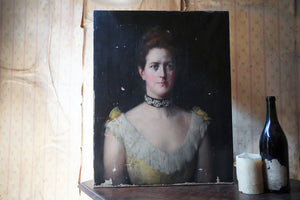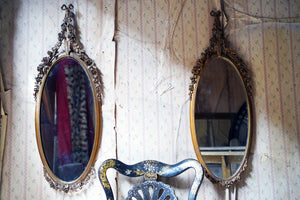Origin: English
Period: Mid-Victorian
Provenance: Unknown
Date: c.1870
Heights: 34” or 19” at seats
Widths: 96”
Depths: 16” (at feet)
The attractive pair of large painted pine pews, of ecclesiastical origin and each at eight feet long, displaying all-over comb-work decoration, one in a light sand colour, the other in an elephant brown/grey, each with canted sides and ladder backs to stepped block feet and surviving from the third quarter of nineteenth century England.
The condition of the pews is good and stable. I have personally owned these pews for a decade and due to renovation I could sadly no longer find a place for them. They require no work and all of the painted decoration is original with no over-painting. There are areas where the paint has some thinning where I had a plant pot at each end (for my sins) which could be stained out easily, please refer to the photographs.
Starting in the Regency period one of the uses of painting in furniture was to imitate more exotic and expensive wood grains buy painting and applying them to more accessible woods such as pine. Faux bois (from the French for false wood) refers to the artistic imitation of wood or wood grains in various media. The craft has roots in the Renaissance with trompe-l'œil. It was probably first crafted with concrete using an iron armature by garden craftsmen in France called "rocailleurs" using common iron materials: rods, barrel bands, and chicken wire.
In the early church people stood to worship, and we can see that reflected in art – from the walls of the catacombs to more sophisticated renderings. Pew use increased during the 14th and 15th centuries and by the 16th century pews were common. The Reformation contributed greatly to the pew design – the Reformers placed the emphasis on hearing, not seeing, and they rejected the lush visual elements of worship. So, to emphasize hearing the Word of God, the people sat.
It proves hard to find church pews that are painted in any sort of manner, making them a lot more appealing than the more commonly seen pitch pine or oak examples.
Period: Mid-Victorian
Provenance: Unknown
Date: c.1870
Heights: 34” or 19” at seats
Widths: 96”
Depths: 16” (at feet)
The attractive pair of large painted pine pews, of ecclesiastical origin and each at eight feet long, displaying all-over comb-work decoration, one in a light sand colour, the other in an elephant brown/grey, each with canted sides and ladder backs to stepped block feet and surviving from the third quarter of nineteenth century England.
The condition of the pews is good and stable. I have personally owned these pews for a decade and due to renovation I could sadly no longer find a place for them. They require no work and all of the painted decoration is original with no over-painting. There are areas where the paint has some thinning where I had a plant pot at each end (for my sins) which could be stained out easily, please refer to the photographs.
Starting in the Regency period one of the uses of painting in furniture was to imitate more exotic and expensive wood grains buy painting and applying them to more accessible woods such as pine. Faux bois (from the French for false wood) refers to the artistic imitation of wood or wood grains in various media. The craft has roots in the Renaissance with trompe-l'œil. It was probably first crafted with concrete using an iron armature by garden craftsmen in France called "rocailleurs" using common iron materials: rods, barrel bands, and chicken wire.
In the early church people stood to worship, and we can see that reflected in art – from the walls of the catacombs to more sophisticated renderings. Pew use increased during the 14th and 15th centuries and by the 16th century pews were common. The Reformation contributed greatly to the pew design – the Reformers placed the emphasis on hearing, not seeing, and they rejected the lush visual elements of worship. So, to emphasize hearing the Word of God, the people sat.
It proves hard to find church pews that are painted in any sort of manner, making them a lot more appealing than the more commonly seen pitch pine or oak examples.








































